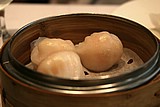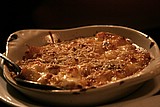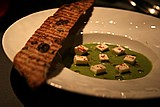Home |
Restaurants by City
|
Food Photography |
Archive | Philosophy |
![]()
Right now we are eating in Seattle, Washington.
|
Wednesday
2005
Permalink
|
"Love, Like, or Other?", March 2, 2005 I spend an unhealthy amount of time thinking about how to evaluate food. Mostly restaurants in fact. I also spend quite a bit of time lamenting why I can't find more restaurants that I really like. These are essentially the same topic in my mind. The truth is that I feel a natural affinity for people who dislike critics. After all, where's the art in criticizing others? And where's the humanity in it? These people put their hearts on the line every day. And critics come along and render their "expert" opinions, shooting arrows from a distance. From the comfort of their keyboard. For over two years I have made it clear that I love two things. I love finding wonderful food experiences, and I love sharing them with others. That's not criticism. Is it? That's just passion for food. But really that's not entirely true. This site already contains what are essentially hundreds of restaurant and food reviews. And now we're on our way down the slippery slope. The next step is coming up with shorthand. Three stars from Michelin (now surveying New York for the first time), four from the New York Times... we have Love, Like, and Other. The definitions are here. But the truth is that they are difficult to define for us. Remember something... writing about food is completely subjective. Yes, there is a general framework for how to evaluate a food experience, but it is simply impossible to be objective. And because so much of one's own expectations color their opinions of a food experience, eating (and deciding what food you enjoy most), it's ultimately very very personal. And so this site is really a personal expression. But that said, we still have the shorthand. What does it really mean? Well, we never talk about the shorthand as we write about a restaurant as there's always texture. But when you review a list of restaurants in a city, we put them in categories for you. Categories that give you a sense of which we think are better than the others. Every meal we eat together ends with a simple question: "love, like, or other?" Sometimes we've even considered creating a fourth category, for the highest echelon of eating experiences. But it's not clear what the point would be given how few there are. Ultimately here is the key: Making good food is easy (even I can do it if I really try). Making great food is hard. Making great food consistently is really really hard. Making great food consistently for a lot of people is nearly impossible. Great food can be from a street vendor, or a 20 course tasting menu at an expensive restaurant. Great food doesn't discriminate. But the physics of making great food is consistent - like gravity. Standards, focus, and lack of compromise are what make great food. And just as with figure skating at the Winter Olympics, there are degrees of difficulty. But unlike the Olympics, we don't discriminate. If you do a simple jump and it's a ten, it's a ten. If you do a triple lutz, they give you extra points. We don't. Is that the right thing? I don't know. On the one hand I think that people should get credit for trying something with a greater difficulty. On the other hand, I also feel like if you try to do something more complicated, you made your bed. And if we only gave our highest recognition to restaurants trying to make the most difficult food, then our "Loves" would look like the list of four star restaurants from the New York Times: Daniel, Jean Georges, Le Bernadin, Masa, Per Se (Ducasse lost his fourth star recently). They're all very expensive, and until Per Se and Masa were added they were all very French. (I think this list is complete, but for some unknown reason the New York Times website has eliminated the ability to search based on star rating). It's nice to know that even the very chefs who've earned these stars know that not all good food is expensive: "Mr. Keller says he used to have a weakness for Burger King's Whopper with extra cheese and French fries, but now that he lives in California, he has switched his allegiance to the cheeseburgers at In-N-Out Burger, with French fries and a milkshake." It's also nice to know that these same chefs follow the same protocol as we do when going out to eat: "How often to eat can also be an issue. Mr. Trotter, for one, limits the number of evening meals on his travels to one, but 15 years ago, he said, he would pack away "three full dinners - I don't mean grazing - just to see what's going on." When you're young, you can do it, " Mr. Trotter, now 45, says. "I would eat for two hours at 5:30, for an hour and a half at 8 p.m., and then I'd eat again. I'd be with two or three other people, and we'd order six appetizers and eight entrees. I was like an eating machine." So we're back to standards, focus, and lack of compromise. And art and commerce don't mix. Not compromising doesn't seem so admirable when nobody's coming to eat in your restaurant. Not compromising, and making a successful business is nearly impossible. Nearly. And so there are restaurants that stay focused. That have maniacal attention to detail. And ultimately believe that quality and consistency are one in the same. Those are the ones I'm looking for. Those are the ones we try to talk about on this site. And while you might expect that someone who spends all this time criticizing might enjoy being negative, I swear it's not true. I get the most personal enjoyment from finding something great and sharing it with others. I wish I could do it more often.
|
|
Our Sponsors
Free Car Listings Hot Tubs Stools Saunas Bar Stools - Calendar and Event Schedules - Food Events and Calendars - Wine Events and Calendars - Digital Photography Resources - Software for Advertisers - Jewish Gifts and Judaica - Howard Stern Podcast - ponytailed blogger Jonathan Schwartz

Browse tastingmenu
Home |
Restaurants by City X |
Food Photography |
Archive | Philosophy |
![]()
Free eBooks: All About Apples
| Autumn Omakase
More:
Discussion |
Cool Food T-Shirts |
Ingredients
| Markets |
Recipes
Search |
Blog FAQ |
Other
Blogs
Best of tastingmenu
|
City View
Entry: July 6, 2006 |
Blue Plate
Entry: June 19, 2006 |
L'Atelier de Joël Robuchon
Entry: July 18, 2006 |
Browse by City
Boston | Chicago | Houston | Las Vegas | Los Angeles | Maui | New York | Philadelphia | Portland | San Francisco | Seattle | Toronto | Utah | Vancouver | Washington D.C.
Bangkok | Beijing | Hong Kong | Seoul | Tokyo
Amsterdam | Berlin | Italy | London | Madrid | Paris | Vienna
Browse by Month
2006
2005
2004
2003
2002
2001
Comments, questions, or feedback:
info / at / tastingmenu / dot / com
All pages Copyright (c) 2001-2006 tastingmenu.com
Last modified 01/30/07.



